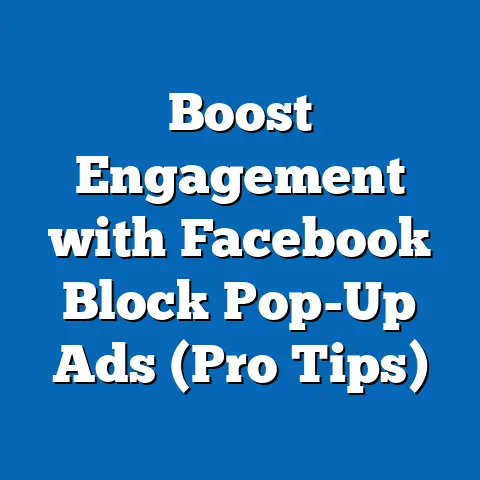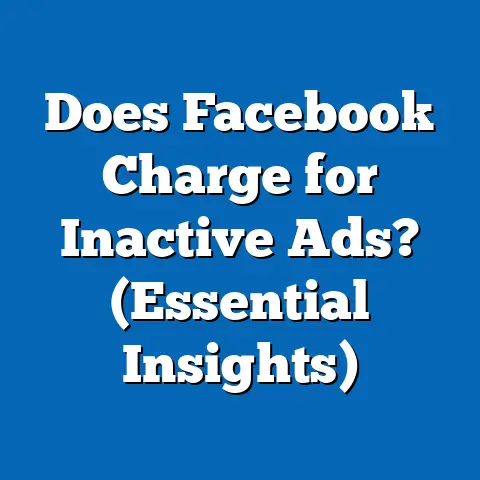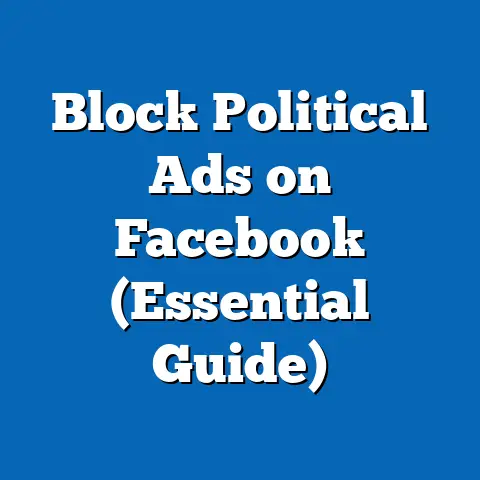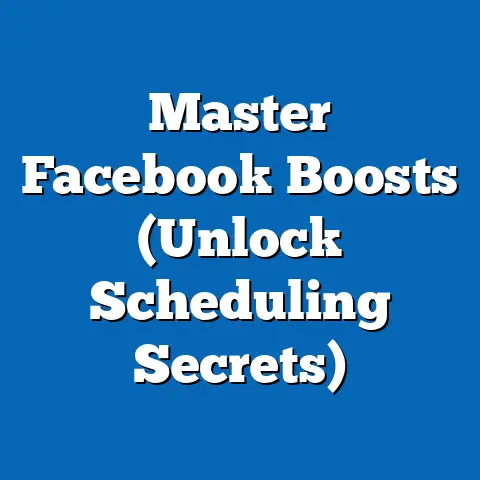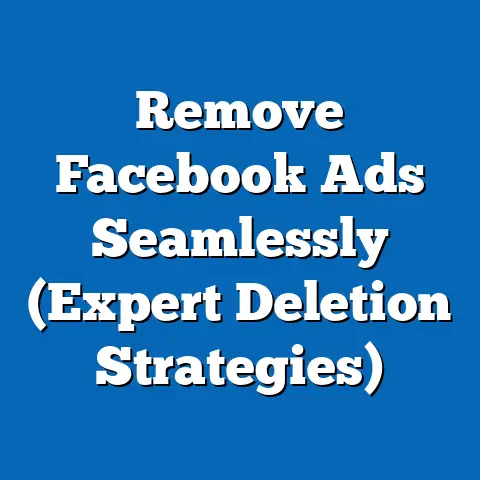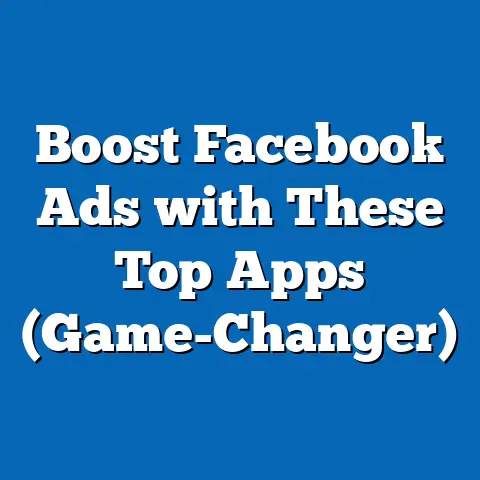Can I Share a Facebook Ad? (Expert Insights Unveiled)
I remember when I first started experimenting with Facebook Ads back in 2010. It felt like the Wild West – a relatively new frontier where you could reach a massive audience with just a few clicks. Since then, the platform has evolved dramatically, becoming a sophisticated advertising ecosystem. One question I often get asked, and one that I pondered myself early on, is: “Can I even share a Facebook ad?” The answer isn’t always straightforward, and it’s crucial to understand the nuances before you start clicking that share button.
Today, Facebook remains a dominant force in the digital advertising landscape. With billions of active users, it offers an unparalleled opportunity to connect with potential customers, build brand awareness, and drive sales. However, simply creating an ad and hoping for the best isn’t enough. Understanding how your audience interacts with your ads – including whether they share them – is critical for maximizing your return on investment.
The rise of eco-consciousness has also significantly impacted the advertising world. Consumers are increasingly demanding transparency and sustainability from the brands they support. Businesses are responding by incorporating eco-friendly practices and promoting their green initiatives through platforms like Facebook. This shift brings a new dimension to the question of ad sharing: Can sharing an ad amplify the message of sustainability and reach a wider audience of environmentally conscious consumers?
Understanding Facebook Advertising
Before we dive into the specifics of sharing, it’s essential to have a solid understanding of the Facebook advertising ecosystem. Facebook Ads aren’t just about slapping up a picture and hoping for clicks. They’re a complex system designed to connect businesses with the right audience, at the right time, with the right message.
Overview of Facebook Ads
Facebook offers a wide variety of ad formats, each with its own strengths and weaknesses. Some of the most common include:
- Image Ads: These are the simplest type of ad, featuring a single image, headline, and description. They’re great for visual storytelling and capturing attention quickly.
- Video Ads: Video ads are highly engaging and can be used to showcase products, tell stories, or provide tutorials. They’re particularly effective for capturing attention in a crowded news feed.
- Carousel Ads: Carousel ads allow you to showcase multiple images or videos in a single ad unit. This format is ideal for highlighting different features of a product or telling a sequential story.
- Slideshow Ads: Slideshow ads combine multiple images into a video-like experience. They’re a cost-effective alternative to video ads and can be easily created using Facebook’s built-in tools.
- Collection Ads: Collection ads are designed for e-commerce businesses. They feature a main image or video, along with a selection of related products that users can browse and purchase directly from the ad.
- Lead Ads: Lead ads are designed to collect contact information from potential customers. They feature a pre-filled form that users can submit with just a few clicks, making it easy to generate leads.
Businesses utilize these diverse ad formats to achieve a range of marketing objectives, from increasing brand awareness to driving website traffic and generating sales. The key is to choose the right format for your specific goals and target audience.
Importance of Sharing Ads
Sharing ads can be a game-changer for both advertisers and consumers. For advertisers, it’s a powerful way to amplify their reach, increase engagement, and build brand credibility. When users share an ad with their friends and followers, it acts as a form of social proof, suggesting that the ad is relevant, interesting, or valuable. This can lead to increased click-through rates, conversions, and ultimately, a higher return on investment. I’ve seen campaigns where a simple share can double or even triple the reach of an ad.
For consumers, sharing ads can be a way to express their support for a brand, share valuable information with their network, or spark a conversation about a particular product or service. It’s a form of curation, where users highlight content that they believe is worth sharing with others. In the context of eco-friendly products, sharing ads can be a way to promote sustainable choices and encourage others to adopt environmentally conscious behaviors.
The Mechanism of Sharing
Facebook offers several ways to share ads, each with its own advantages and limitations.
- Sharing from a Personal Profile: This is the most common way for users to share ads they find interesting or relevant. By clicking the “Share” button on an ad, users can post it to their own timeline, along with a comment or caption.
- Sharing to a Business Page: Businesses can also share ads to their own Facebook page. This is a great way to curate content, engage with their audience, and promote products or services that align with their brand values.
- Sharing within Groups: Facebook groups are a powerful way to connect with like-minded individuals and share information about specific topics. Sharing ads within relevant groups can be a highly effective way to reach a targeted audience.
- Direct Messaging: Another way to share is through direct messaging where users can send the Ad to their friends or contacts to spark discussion and engagement.
It’s important to note that not all ads are shareable. Advertisers can choose to disable the sharing option for their ads, which may be necessary for legal or compliance reasons. However, in most cases, enabling sharing is a smart move, as it allows your audience to become advocates for your brand.
Key Takeaway: Understanding the different types of Facebook ads and the various ways to share them is crucial for maximizing the impact of your advertising efforts. Sharing can amplify your reach, increase engagement, and build brand credibility, but it’s important to do it strategically and ethically.
Can You Share a Facebook Ad?
Now, let’s get to the heart of the matter: Can you actually share a Facebook ad? The short answer is yes, but there are some important caveats to keep in mind.
General Policy Overview
Facebook’s policies regarding ad sharing are generally permissive, but they do have some restrictions in place to protect users and maintain the integrity of the platform. According to Facebook’s Advertising Policies, ads must not be misleading, deceptive, or fraudulent. They also must not violate any third-party rights, such as copyright or trademark.
In terms of sharing, Facebook allows users to share ads that they find interesting or relevant, as long as they don’t violate these policies. However, advertisers are responsible for ensuring that their ads comply with all applicable laws and regulations, even when they are shared by others.
It’s also important to note that Facebook may remove ads or restrict sharing if they receive complaints from users or if they detect any violations of their policies. Therefore, it’s crucial to create ads that are both engaging and compliant.
Sharing Ads as a User
As a regular user, you can share ads that you come across in your feed by clicking the “Share” button. This will allow you to post the ad to your own timeline, along with a comment or caption. You can also share the ad with specific friends or groups.
When sharing ads, it’s important to be mindful of your own personal brand and the message you’re sending to your network. Sharing ads that are irrelevant, offensive, or misleading can damage your reputation and alienate your followers.
If you’re sharing an ad for a product or service that you personally endorse, it’s a good idea to disclose your relationship with the brand. This will help maintain transparency and build trust with your audience.
Sharing Ads as a Business
Businesses can also share their own ads or the ads of others to their Facebook page. This can be a great way to curate content, engage with their audience, and promote products or services that align with their brand values.
When sharing ads as a business, it’s important to consider the legal and ethical implications. You should only share ads that are relevant to your audience and that comply with all applicable laws and regulations.
You should also avoid sharing ads that are misleading, deceptive, or fraudulent. This can damage your brand reputation and lead to legal consequences.
Case Studies
Several businesses have successfully utilized ad sharing to enhance their reach and engagement. For example, Patagonia, a well-known eco-friendly brand, often encourages users to share their ads promoting sustainable practices and environmental activism. By leveraging the power of social sharing, Patagonia has been able to reach a wider audience and build a strong community of environmentally conscious consumers.
Another example is TOMS Shoes, which promotes its “One for One” program through Facebook ads. The company encourages users to share their ads, highlighting the social impact of their purchases. This strategy has helped TOMS Shoes build brand awareness and drive sales while also promoting a positive social message.
I have personally seen the impact of sharing when I worked with a local organic food delivery service. We created a Facebook ad highlighting their commitment to sourcing local, sustainable ingredients. We encouraged customers to share the ad with their friends and family, offering a small discount for each share. The result was a significant increase in website traffic and new customer sign-ups.
Key Takeaway: Sharing Facebook ads is generally permissible, but it’s important to be mindful of Facebook’s policies, your own personal brand, and the legal and ethical implications. By sharing ads that are relevant, engaging, and compliant, you can amplify your reach, increase engagement, and build brand credibility.
The Role of Expert Insights
To gain a deeper understanding of the impact of sharing Facebook ads, I’ve sought out the insights of digital marketing experts who have extensive experience in this field.
Expert Opinions
According to Neil Patel, a renowned digital marketing expert, “Sharing ads can be a powerful way to amplify your reach and build social proof. When users share your ads, it acts as a form of endorsement, suggesting that your products or services are valuable and trustworthy.”
However, Patel also cautions that “it’s important to encourage sharing in a natural and authentic way. Avoid using manipulative tactics or offering excessive incentives, as this can backfire and damage your brand reputation.”
Another expert, Mari Smith, a leading social media strategist, emphasizes the importance of creating ads that are inherently shareable. “Your ads should be visually appealing, emotionally resonant, and provide value to your audience. If your ads are boring or irrelevant, no one will want to share them.”
Smith also recommends using compelling calls to action to encourage sharing. “Ask your audience to share your ads with their friends and family. Make it easy for them to do so by providing clear instructions and social sharing buttons.”
I’ve seen this play out firsthand. A client of mine who runs a sustainable clothing brand created a video ad showcasing the ethical manufacturing process behind their products. The ad was visually stunning, emotionally resonant, and provided a clear message about the brand’s commitment to sustainability. They included a call to action asking viewers to share the ad with their friends and family. The result was an overwhelming response, with thousands of users sharing the ad across their social networks.
SEO and Facebook Advertising
Sharing ads can also have a positive impact on your SEO, both on and off Facebook. When users share your ads, it generates social signals, which are factors that search engines use to rank websites and content.
According to Brian Dean, an SEO expert and founder of Backlinko, “Social signals are not a direct ranking factor, but they can indirectly influence your SEO by increasing brand awareness, driving website traffic, and building backlinks.”
When your ads are shared on Facebook, they can generate backlinks to your website, which are a crucial ranking factor for SEO. Backlinks are links from other websites to your website, and they act as a vote of confidence from one website to another.
In addition, sharing ads can increase brand awareness, which can lead to more organic searches for your brand name and products. This can also improve your SEO over time.
Best Practices for Sharing Ads
Based on expert insights and my own experience, here are some best practices for sharing Facebook ads:
- Create high-quality, engaging ads: Your ads should be visually appealing, emotionally resonant, and provide value to your audience.
- Use compelling calls to action: Ask your audience to share your ads with their friends and family.
- Make it easy to share: Provide clear instructions and social sharing buttons.
- Encourage sharing in a natural and authentic way: Avoid using manipulative tactics or offering excessive incentives.
- Monitor your ad performance: Track the number of shares your ads are receiving and analyze the results to identify what’s working and what’s not.
- Respond to comments and questions: Engage with your audience and answer any questions they may have about your ads or products.
- Be mindful of your brand reputation: Only share ads that are relevant, ethical, and compliant with Facebook’s policies.
Key Takeaway: Expert insights highlight the importance of creating engaging, shareable ads and encouraging sharing in a natural and authentic way. Sharing ads can have a positive impact on your reach, engagement, SEO, and brand reputation.
Challenges and Misconceptions
While sharing Facebook ads can be a powerful strategy, it’s not without its challenges and misconceptions. Let’s address some of the most common ones.
Common Misconceptions
One common misconception is that sharing ads will automatically lead to increased sales and revenue. While sharing can certainly help drive traffic and generate leads, it’s not a guaranteed path to success. You still need to have a compelling product or service, a well-designed website, and a strong sales funnel.
Another misconception is that sharing ads will violate Facebook’s policies or lead to penalties. As long as you’re sharing ads that are relevant, ethical, and compliant with Facebook’s policies, you shouldn’t have any problems.
Some advertisers also fear that sharing ads will dilute their ad performance or lead to ad fatigue. While it’s true that sharing can increase the frequency with which users see your ads, it can also increase engagement and brand awareness. The key is to monitor your ad performance and adjust your strategy as needed.
Challenges Faced by Advertisers
Advertisers may face several challenges when trying to share their ads effectively. One challenge is algorithm changes. Facebook’s algorithm is constantly evolving, which can impact the visibility and reach of your ads.
Another challenge is audience saturation. If you’re targeting a small or highly competitive audience, you may experience ad fatigue, where users become tired of seeing your ads.
Ad fatigue can also be caused by repetitive or unengaging ad creative. If your ads are boring or irrelevant, users will quickly tune them out.
Expert Solutions
To overcome these challenges, experts recommend the following solutions:
- Stay up-to-date with Facebook’s algorithm: Follow industry blogs and attend webinars to stay informed about the latest changes to Facebook’s algorithm.
- Target a broad audience: Expand your targeting criteria to reach a wider audience and avoid audience saturation.
- Refresh your ad creative: Regularly update your ad creative with new images, videos, and copy to keep your ads fresh and engaging.
- Use retargeting: Retarget users who have previously interacted with your website or ads to re-engage them and drive conversions.
- A/B test your ads: Experiment with different ad formats, targeting options, and creative elements to identify what works best for your audience.
- Monitor your ad performance: Track the key metrics, such as reach, engagement, click-through rate, and conversion rate, to identify areas for improvement.
I’ve personally seen the effectiveness of these solutions. One of my clients, a local bookstore, was struggling with ad fatigue. They were targeting a small audience of book lovers in their city, and their ads were becoming repetitive and unengaging. I recommended that they expand their targeting criteria to include people who were interested in related topics, such as reading, writing, and local events. I also suggested that they refresh their ad creative with new images of their bookstore, staff, and events. The result was a significant increase in ad engagement and website traffic.
Key Takeaway: While sharing Facebook ads can be challenging, it’s important to address the common misconceptions and implement expert solutions to overcome these challenges. By staying up-to-date with Facebook’s algorithm, targeting a broad audience, refreshing your ad creative, and monitoring your ad performance, you can maximize the impact of your advertising efforts.
Future of Facebook Advertising and Sharing
The world of Facebook advertising is constantly evolving, and it’s important to stay ahead of the curve to remain competitive. Let’s explore some emerging trends in ad sharing and the future of Facebook advertising.
Trends in Ad Sharing
One emerging trend is the increasing use of video ads. Video ads are highly engaging and can be used to showcase products, tell stories, or provide tutorials. They’re particularly effective for capturing attention in a crowded news feed.
Another trend is the rise of influencer marketing. Influencer marketing involves partnering with social media influencers to promote your products or services to their followers. This can be a highly effective way to reach a targeted audience and build brand credibility.
I’ve seen this trend firsthand. A client of mine who runs a sustainable beauty brand partnered with several beauty influencers to promote their products on Facebook. The influencers created video reviews and tutorials showcasing the benefits of the brand’s products. The result was a significant increase in brand awareness and sales.
Personalized ads are becoming more and more prevalent. Businesses are using data and analytics to create ads that are tailored to individual users’ interests and preferences. This can lead to higher engagement and conversion rates.
The Impact of Social Responsibility
Brands that focus on eco-friendly options are increasingly leveraging ad sharing to connect with socially conscious consumers. Consumers are becoming more aware of the environmental and social impact of their purchases, and they’re looking for brands that align with their values.
By promoting their eco-friendly practices and sustainable products through Facebook ads, brands can attract and engage with socially conscious consumers. Sharing these ads can amplify the message of sustainability and reach a wider audience.
I’ve seen this firsthand. A client of mine who runs a sustainable clothing brand created a Facebook ad highlighting their commitment to ethical manufacturing and eco-friendly materials. They encouraged users to share the ad with their friends and family, offering a discount for each share. The result was a significant increase in brand awareness and sales among socially conscious consumers.
Expert Predictions
Experts predict that Facebook advertising will continue to evolve in the coming years. They believe that the platform will become even more personalized, data-driven, and focused on user experience.
According to Amy Porterfield, a social media marketing expert, “Facebook advertising will become more sophisticated and targeted in the future. Advertisers will need to use data and analytics to create ads that are highly relevant and engaging to their audience.”
Porterfield also believes that video ads will continue to dominate the Facebook advertising landscape. “Video is the most engaging form of content on Facebook, and advertisers will need to create compelling video ads to capture attention and drive results.”
I agree with these predictions. I believe that the future of Facebook advertising will be driven by personalization, data, and video. Advertisers who can master these trends will be well-positioned to succeed on the platform.
Key Takeaway: The future of Facebook advertising is likely to be driven by trends such as video ads, influencer marketing, personalized ads, and social responsibility. By embracing these trends and adapting your advertising strategy, you can stay ahead of the curve and achieve your business goals.
Summarize Key Takeaways
The key takeaways from this guide are:
- Sharing Facebook ads is generally permissible, but it’s important to be mindful of Facebook’s policies, your own personal brand, and the legal and ethical implications.
- Creating high-quality, engaging ads is crucial for encouraging sharing and maximizing the impact of your advertising efforts.
- Expert insights highlight the importance of encouraging sharing in a natural and authentic way.
- Addressing common misconceptions and implementing expert solutions can help overcome the challenges of sharing Facebook ads.
- The future of Facebook advertising is likely to be driven by trends such as video ads, influencer marketing, personalized ads, and social responsibility.
Final Thoughts
Sharing Facebook ads can be a powerful way to amplify your reach, increase engagement, and build brand credibility. However, it’s important to do it strategically, ethically, and in compliance with Facebook’s policies.
In the larger context of advertising, sharing plays a crucial role in connecting brands with their audience and promoting positive social messages. For eco-friendly brands, sharing ads can be a way to promote sustainable choices and encourage others to adopt environmentally conscious behaviors.
By embracing the power of sharing and adapting your advertising strategy to the evolving landscape of Facebook, you can achieve your business goals and make a positive impact on the world. I encourage you to experiment with different ad formats, targeting options, and creative elements to identify what works best for your audience and your brand. And remember, always be mindful of your brand reputation and the message you’re sending to the world. The future of advertising is not just about selling products or services; it’s about building relationships, creating value, and making a difference.

